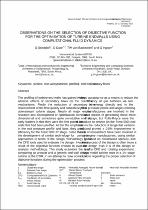 ResearchSpace
ResearchSpace
Observations on the selection of objective function for the optimisation of turbine endwalls using computational fluid dynamics
JavaScript is disabled for your browser. Some features of this site may not work without it.
- ResearchSpace
- →
- Research Publications/Outputs
- →
- Conference Publications
- →
- View Item
| dc.contributor.author |
Snedden, Glen C

|
|
| dc.contributor.author |
Dunn, Dwain I

|
|
| dc.contributor.author |
Von Backström, TW

|
|
| dc.contributor.author |
Ingram, G

|
|
| dc.date.accessioned | 2010-02-10T14:58:28Z | |
| dc.date.available | 2010-02-10T14:58:28Z | |
| dc.date.issued | 2010-01 | |
| dc.identifier.citation | Snedden, GC, Dunn, D et al. 2010. Observations on the selection of objective function for the optimisation of turbine endwalls using computational fluid dynamics. 7th South African Conference on Computational and Applied Mechanics (SACAM10). Pretoria, 10-13 January 2010, pp 1-15 | en |
| dc.identifier.uri | http://hdl.handle.net/10204/3939 | |
| dc.description | 7th South African Conference on Computational and Applied Mechanics (SACAM10) | en |
| dc.description.abstract | This study examines the results of a CFD and rotating experiment, comparing an annular and a generic end wall design for a model turbine rotor in a 1½ stage turbine at the CSIR, in an attempt to draw some conclusions regarding the proper selection of objective functions during the optimisation process. The CSIR has a rich body of experimental and computational data from a rotating test rig with both profiled and planar end walls, which provides an ideal opportunity to examine the validity of various objective functions. A 1½ stage, low speed, turbine test rig, originally of the University of Natal, where it was used for tip loss measurements, has been installed and refurbished at the CSIR. In Figure 3 the general layout and instrumentation of the test rig is indicated. The test rig has a hub and tip radius of 0.142 m and 0.203 m respectively and is designed for a maximum wheel speed of 3000 RPM. A radial fan draws atmospheric air through the rig, inducing a pressure drop of 4.8 kPa for a mass-flow of 3.39 kg/s, corresponding to an inlet velocity of about 30 m/s. The radial fan is driven by an electric motor with variable speed control. The turbine power is absorbed by a hydraulic motor, giving independent rotor speed control. Inlet turbulence intensity was measured to be less than 1%. | en |
| dc.language.iso | en | en |
| dc.publisher | South African Conference on Computational and Applied Mechanics | en |
| dc.subject | Turbine | en |
| dc.subject | Non-axisymmetric | en |
| dc.subject | Endwall | en |
| dc.subject | Secondary flows | en |
| dc.subject | Turbine test rig | en |
| dc.subject | Computational fluid dynamics | en |
| dc.title | Observations on the selection of objective function for the optimisation of turbine endwalls using computational fluid dynamics | en |
| dc.type | Conference Presentation | en |
| dc.identifier.apacitation | Snedden, G. C., Dunn, D. I., Von Backström, T., & Ingram, G. (2010). Observations on the selection of objective function for the optimisation of turbine endwalls using computational fluid dynamics. South African Conference on Computational and Applied Mechanics. http://hdl.handle.net/10204/3939 | en_ZA |
| dc.identifier.chicagocitation | Snedden, Glen C, Dwain I Dunn, TW Von Backström, and G Ingram. "Observations on the selection of objective function for the optimisation of turbine endwalls using computational fluid dynamics." (2010): http://hdl.handle.net/10204/3939 | en_ZA |
| dc.identifier.vancouvercitation | Snedden GC, Dunn DI, Von Backström T, Ingram G, Observations on the selection of objective function for the optimisation of turbine endwalls using computational fluid dynamics; South African Conference on Computational and Applied Mechanics; 2010. http://hdl.handle.net/10204/3939 . | en_ZA |
| dc.identifier.ris | TY - Conference Presentation AU - Snedden, Glen C AU - Dunn, Dwain I AU - Von Backström, TW AU - Ingram, G AB - This study examines the results of a CFD and rotating experiment, comparing an annular and a generic end wall design for a model turbine rotor in a 1½ stage turbine at the CSIR, in an attempt to draw some conclusions regarding the proper selection of objective functions during the optimisation process. The CSIR has a rich body of experimental and computational data from a rotating test rig with both profiled and planar end walls, which provides an ideal opportunity to examine the validity of various objective functions. A 1½ stage, low speed, turbine test rig, originally of the University of Natal, where it was used for tip loss measurements, has been installed and refurbished at the CSIR. In Figure 3 the general layout and instrumentation of the test rig is indicated. The test rig has a hub and tip radius of 0.142 m and 0.203 m respectively and is designed for a maximum wheel speed of 3000 RPM. A radial fan draws atmospheric air through the rig, inducing a pressure drop of 4.8 kPa for a mass-flow of 3.39 kg/s, corresponding to an inlet velocity of about 30 m/s. The radial fan is driven by an electric motor with variable speed control. The turbine power is absorbed by a hydraulic motor, giving independent rotor speed control. Inlet turbulence intensity was measured to be less than 1%. DA - 2010-01 DB - ResearchSpace DP - CSIR KW - Turbine KW - Non-axisymmetric KW - Endwall KW - Secondary flows KW - Turbine test rig KW - Computational fluid dynamics LK - https://researchspace.csir.co.za PY - 2010 T1 - Observations on the selection of objective function for the optimisation of turbine endwalls using computational fluid dynamics TI - Observations on the selection of objective function for the optimisation of turbine endwalls using computational fluid dynamics UR - http://hdl.handle.net/10204/3939 ER - | en_ZA |





